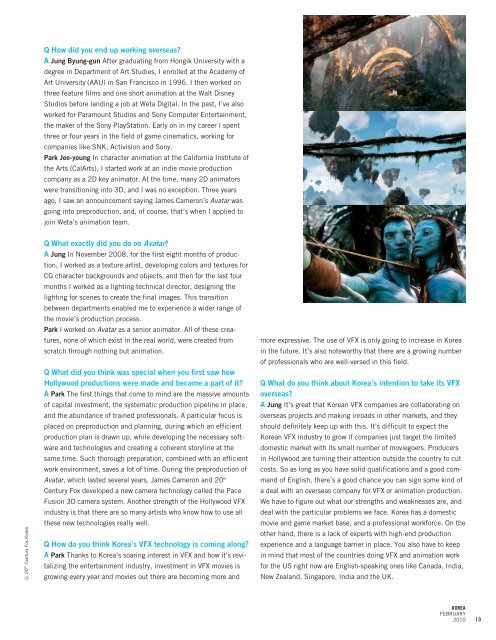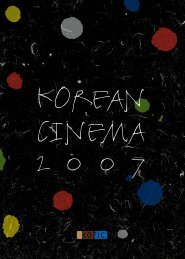www.korea.net
KOREAN MOVIES - Korea.net
KOREAN MOVIES - Korea.net
- No tags were found...
You also want an ePaper? Increase the reach of your titles
YUMPU automatically turns print PDFs into web optimized ePapers that Google loves.
Q How did you end up working overseas?<br />
A Jung Byung-gun After graduating from Hongik University with a<br />
degree in Department of Art Studies, I enrolled at the Academy of<br />
Art University (AAU) in San Francisco in 1996. I then worked on<br />
three feature films and one short animation at the Walt Disney<br />
Studios before landing a job at Weta Digital. In the past, I’ve also<br />
worked for Paramount Studios and Sony Computer Entertainment,<br />
the maker of the Sony PlayStation. Early on in my career I spent<br />
three or four years in the field of game cinematics, working for<br />
companies like SNK, Activision and Sony.<br />
Park Jee-young In character animation at the California Institute of<br />
the Arts (CalArts), I started work at an indie movie production<br />
company as a 2D key animator. At the time, many 2D animators<br />
were transitioning into 3D, and I was no exception. Three years<br />
ago, I saw an announcement saying James Cameron’s Avatar was<br />
going into preproduction, and, of course, that’s when I applied to<br />
join Weta’s animation team.<br />
20 th Century Fox Korea<br />
Q What exactly did you do on Avatar?<br />
A Jung In November 2008, for the first eight months of production,<br />
I worked as a texture artist, developing colors and textures for<br />
CG character backgrounds and objects, and then for the last four<br />
months I worked as a lighting technical director, designing the<br />
lighting for scenes to create the final images. This transition<br />
between departments enabled me to experience a wider range of<br />
the movie’s production process.<br />
Park I worked on Avatar as a senior animator. All of these creatures,<br />
none of which exist in the real world, were created from<br />
scratch through nothing but animation.<br />
Q What did you think was special when you first saw how<br />
Hollywood productions were made and became a part of it?<br />
A Park The first things that come to mind are the massive amounts<br />
of capital investment, the systematic production pipeline in place,<br />
and the abundance of trained professionals. A particular focus is<br />
placed on preproduction and planning, during which an efficient<br />
production plan is drawn up, while developing the necessary software<br />
and technologies and creating a coherent storyline at the<br />
same time. Such thorough preparation, combined with an efficient<br />
work environment, saves a lot of time. During the preproduction of<br />
Avatar, which lasted several years, James Cameron and 20 th<br />
Century Fox developed a new camera technology called the Pace<br />
Fusion 3D camera system. Another strength of the Hollywood VFX<br />
industry is that there are so many artists who know how to use all<br />
these new technologies really well.<br />
Q How do you think Korea’s VFX technology is coming along?<br />
A Park Thanks to Korea’s soaring interest in VFX and how it’s revitalizing<br />
the entertainment industry, investment in VFX movies is<br />
growing every year and movies out there are becoming more and<br />
more expressive. The use of VFX is only going to increase in Korea<br />
in the future. It’s also noteworthy that there are a growing number<br />
of professionals who are well-versed in this field.<br />
Q What do you think about Korea’s intention to take its VFX<br />
overseas?<br />
A Jung It’s great that Korean VFX companies are collaborating on<br />
overseas projects and making inroads in other markets, and they<br />
should definitely keep up with this. It’s difficult to expect the<br />
Korean VFX industry to grow if companies just target the limited<br />
domestic market with its small number of moviegoers. Producers<br />
in Hollywood are turning their attention outside the country to cut<br />
costs. So as long as you have solid qualifications and a good command<br />
of English, there’s a good chance you can sign some kind of<br />
a deal with an overseas company for VFX or animation production.<br />
We have to figure out what our strengths and weaknesses are, and<br />
deal with the particular problems we face. Korea has a domestic<br />
movie and game market base, and a professional workforce. On the<br />
other hand, there is a lack of experts with high-end production<br />
experience and a language barrier in place. You also have to keep<br />
in mind that most of the countries doing VFX and animation work<br />
for the US right now are English-speaking ones like Canada, India,<br />
New Zealand, Singapore, India and the UK.<br />
KOREA<br />
FEBRUARY<br />
2010<br />
13
















